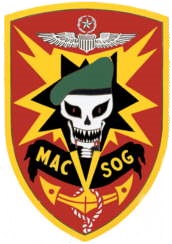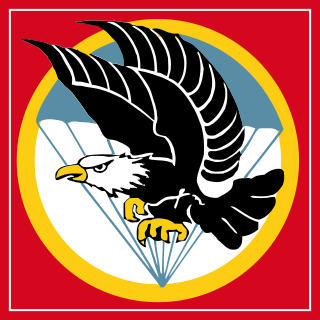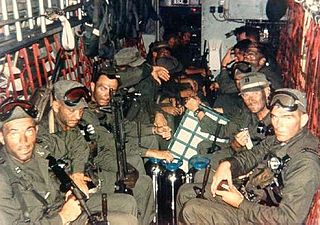Related Research Articles

The Vietnam War was a conflict in Vietnam, Laos, and Cambodia that began on 1 November 1955, when the United States government gave military assistance to the South Vietnam regimeand ended with the capture of Saigon, the capital of South Vietnam, by the People's Army of Vietnam and the National Liberation Front of South Vietnam on 30 April 1975. It was the second of the Indochina Wars and was officially fought between North Vietnam and South Vietnam. The north was supported by the Soviet Union, China, and other communist states, while the south was supported by the United States and other anti-communist allies. The war is widely considered to be a Cold War-era proxy war. It lasted almost 20 years, with direct U.S. involvement ending in 1973. The conflict also spilled over into neighboring states, exacerbating the Laotian Civil War and the Cambodian Civil War, which ended with all three countries officially becoming communist states by 1976.

The Viet Cong was an armed communist organization and movement in South Vietnam, Laos and Cambodia. Formally organized as the National Liberation Front of South Vietnam, it fought under the direction of North Vietnam against the South Vietnamese and United States governments during the Vietnam War. The organization had both guerrilla and regular army units, as well as a network of cadres who organized and mobilized peasants in the territory the Viet Cong controlled. During the war, communist fighters and some anti-war activists claimed that the Viet Cong was an insurgency indigenous to the South, while the U.S. and South Vietnamese governments portrayed the group as a tool of North Vietnam. According to Trần Văn Trà, the Viet Cong's top commander, and the post-war Vietnamese government's official history, the Viet Cong followed orders from Hanoi and were practically part of the People's Army of Vietnam, or North Vietnamese army.

The Cambodian Civil War was a civil war in Cambodia fought between the forces of the Communist Party of Kampuchea against the government forces of the Kingdom of Cambodia and, after October 1970, the Khmer Republic, which had succeeded the kingdom.

The battle of Dak To in Vietnam was a series of major engagements of the Vietnam War that took place between 3 and 23 November 1967, in Kon Tum Province, in the Central Highlands of the Republic of Vietnam. The action at Đắk Tô was one of a series of People's Army of Vietnam (PAVN) offensive initiatives that began during the second half of the year. PAVN attacks at Lộc Ninh, Song Be and at Con Thien and Khe Sanh,, were other actions which, combined with Đắk Tô, became known as "the border battles". The post hoc purported objective of the PAVN forces was to distract American and South Vietnamese forces away from cities towards the borders in preparation for the Tet Offensive.

The Battle of Ia Drang was the first major battle between the United States Army and the People's Army of Vietnam (PAVN), as part of the Pleiku Campaign conducted early in the Vietnam War, at the eastern foot of the Chu Pong Massif in the central highlands of Vietnam, in 1965. It is notable for being the first large scale helicopter air assault and also the first use of Boeing B-52 Stratofortress strategic bombers in a tactical support role. Ia Drang set the blueprint for the Vietnam War with the Americans relying on air mobility, artillery fire and close air support, while the PAVN neutralized that firepower by quickly engaging American forces at very close range.

Ngô Quang Trưởng was an officer in the Army of the Republic of Vietnam (ARVN). Trưởng gained his commission in the Vietnamese National Army in 1954 and moved up the ranks over the next decade, mostly in the Airborne Brigade. In 1966, Trưởng commanded a division for the first time after he was given command of the 1st Division after helping to quell the Buddhist Uprising. He rebuilt the unit after this divisive period and used it to repel the communists and reclaimed the imperial citadel of Huế after weeks of bitter street fighting during the Tết Offensive. In 1970, Trưởng was given command of IV Corps in the Mekong Delta and improved the situation there to such an extent that he allowed some of his forces to be redeployed to other parts of the country that were finding the communist pressure difficult.

Major General Nguyễn Văn Hiếu was a general in the South Vietnamese Army of the Republic of Vietnam (ARVN). As a child he lived in Shanghai. He later emigrated with his ethnic Vietnamese parents to Saigon when the Chinese Communist Party took over China in 1949. He attended Aurore University in Shanghai, China. In 1950, he attended the Vietnamese Military Academy, graduating second in his class in 1951. In 1963, he graduated from Command and General Staff College, at Fort Leavenworth, Kansas.

Military Assistance Command, Vietnam – Studies and Observations Group (MACV-SOG) was a highly classified, multi-service United States special operations unit which conducted covert unconventional warfare operations before and during the Vietnam War.

The Cambodian campaign was a brief series of military operations conducted in eastern Cambodia in 1970 by South Vietnam and the United States as an extension of the Vietnam War and the Cambodian Civil War. Thirteen major operations were conducted by the Army of the Republic of Vietnam (ARVN) between 29 April and 22 July and by U.S. forces between 1 May and 30 June 1970.
The 1975 spring offensive, officially known as the general offensive and uprising of spring 1975, was the final North Vietnamese campaign in the Vietnam War that led to the capitulation of Republic of Vietnam. After the initial success capturing Phước Long Province, the North Vietnamese leadership increased the scope of the People's Army of Vietnam's (PAVN) offensive and captured and held the key Central Highlands city of Buôn Ma Thuột between 10 and 18 March. These operations were intended to be preparatory to launching a general offensive in 1976.
The Battle of Svay Rieng was the last major offensive operation of the Vietnam War to be mounted by the South Vietnamese Army of the Republic of Vietnam (ARVN) against the North Vietnamese People's Army of Vietnam (PAVN) forces.

Operation Chenla I or Chenla One was a major military operation conducted by the Khmer National Armed Forces (FANK) during the Cambodian Civil War. It began in late August 1970 and ended in February 1971, due to the FANK High Command's decision to withdraw some units from Tang Kauk to protect Phnom Penh after Pochentong airbase was attacked.

The Battle of Huế, also called the siege of Huế, was a major military engagement in the Tết Offensive launched by North Vietnam and the Việt Cộng during the Vietnam War. After initially losing control of most of Huế and its surroundings, the combined South Vietnamese and American forces gradually recaptured the city over one month of intense fighting. The battle was one of the longest and bloodiest of the war, and the battle negatively affected American public perception of the war.

Central Office for South Vietnam, officially known as the Central Executive Committee of the People's Revolutionary Party from 1962 until its dissolution in 1976, was the American term for the North Vietnamese political and military headquarters inside South Vietnam during the Vietnam War. It was envisaged as being in overall command of the communist effort in the southern half of the Republic of Vietnam, which included the efforts of both People's Army of Vietnam (PAVN), the Viet Cong, and the People's Revolutionary Party. Some doubted its existence but in his memoirs the American commander in South Vietnam, General William Westmoreland, spoke of it as something whose existence and importance were not in doubt.
After the 1978 Vietnamese invasion of Cambodia and subsequent collapse of Democratic Kampuchea in 1979, the Khmer Rouge fled to the border regions of Thailand, and, with assistance from China, Pol Pot's troops managed to regroup and reorganize in forested and mountainous zones on the Thai-Cambodian border. During the 1980s and early 1990s Khmer Rouge forces operated from inside refugee camps in Thailand, in an attempt to de-stabilize the pro-Hanoi People's Republic of Kampuchea's government, which Thailand refused to recognise. Thailand and Vietnam faced off across the Thai-Cambodian border with frequent Vietnamese incursions and shellings into Thai territory throughout the 1980s in pursuit of Cambodian guerrillas who kept attacking Vietnamese occupation forces.

The Vietnamese Airborne Division was one of the earliest components of the Republic of Vietnam Military Forces. The Vietnamese Airborne Division began as companies organized in 1948, prior to any agreement over armed forces in Vietnam. After the partition of Vietnam, it became a part of the Army of the Republic of Vietnam. This division had its distinct origins in French-trained paratrooper battalions, with predecessor battalions participating in major battles including Dien Bien Phu and retained distinct uniforms and regalia. With the formation of an independent republic, the colonial paratroopers were dissolved, however regalia and aesthetics alongside the nickname "Bawouans" would be retained.

The United States continued its unilateral withdrawal of forces from South Vietnam notwithstanding the lack of progress at the Paris Peace Talks. The removal of Prince Norodom Sihanouk from power in Cambodia in March and his replacement by General Lon Nol, began the Cambodian Civil War. South Vietnamese and U.S. forces entered Cambodia in late April to attack People's Army of Vietnam (PAVN) and Vietcong (VC) bases and supply lines there which had long been used to support the insurgency in South Vietnam. The expansion of the war revitalized the antiwar movement in the U.S. and led to the Kent State shootings and Jackson State killings in May. While U.S. ground forces withdrew from Cambodia at the end of June and legislation was passed to prevent their reintroduction, the South Vietnamese conducted operations in Cambodia for the rest of the year and the U.S. provided air support and military aid to the Cambodian government. Despite this support the Cambodians lost control of vast areas of the country to the PAVN. Within South Vietnam the second half of the year saw a reduction in large U.S. operations with the focus shifting to pacification and population security and supporting Vietnamization. The PAVN/VC generally reverted to sapper attacks and attacks by fire but they fought hard to defend their base areas and infiltration routes.

1972 in the Vietnam War saw foreign involvement in South Vietnam slowly declining. Three allies, Australia, New Zealand and Thailand, which had each contributed military contingents, left South Vietnam this year. The United States continued to participate in combat, primarily with air power to assist the South Vietnamese, while negotiators in Paris tried to hammer out a peace agreement and withdrawal strategy for the United States.

John Laurence is an American television correspondent, author, print reporter and documentary filmmaker. He is known for his work on the air at CBS News, London correspondent for ABC News, documentary work for PBS and CBS, and his book and magazine writing. He won the George Polk Memorial Award of the Overseas Press Club of America for "best reporting in any medium requiring exceptional courage and enterprise abroad" for his coverage of the Vietnam War in 1970.
Operation Nevada Eagle was a security operation during the Vietnam War in Thừa Thiên Province, that took place from 17 May 1968 to 28 February 1969.
References
- ↑ Salamon, Julie (23 April 2003). "CRITic's NOTEBOOK; Reflecting on TV's Pensive Portrayal of Vietnam". The New York Times.
- ↑ Laurence, John (2001). The Cat from Hue . Public Affairs. p. 540. ISBN 1586481606.
- ↑ Bliss, Edward Jr.(1991). Now the news. p. 349